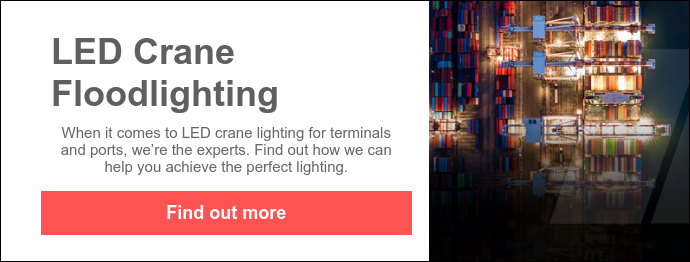This question is more commonly asked than you might think: “Can I use standard high mast LED lights on cranes in ports?” We sat down with our Director, Alexander Krupkin for a quick Q&A.
The short answer
Yes, in theory. High-mast LED lighting can be used on cranes in marine and port environments. In practice, we wouldn’t recommend it as you’re likely to have to replace those lights every six to twelve months. And that doesn’t make much business or operational sense.
The marine operating environment is completely different – and considerably more extreme – than landside operations. And extreme environments need robust, purpose-built solutions able to cope with a range of marine-specific challenges. While it may be possible to reduce initial spend by buying standard lights for cranes, costs will start to build almost as soon as they’re installed.
Three reasons not to buy ‘standard’
- High mast lights will shake themselves apart.
The main consideration for crane lighting is vibration. There’s a huge amount of it. Whether it’s a ship-to-shore crane and or a smaller rubber tire gantry RTG, rail mounted gantry RNG, or mobile harbour variety, all these cranes oscillate with high inertia. If you use a standard high mast light, this mechanical vibration will shake the functioning components loose very rapidly. The LEDs will then have to be replaced. - Salination will be a problem.
The proximity to water means high levels of salt in the operating environment. This can (and likely will) have a severe corrosive effect on the body of the light. It won’t happen immediately but after 24 months or so high levels of corrosion will begin to cause faults and failures. Combine this with water ingress and the chances of malfunction increase. - Particle ingress will impact operation.
The cargo being loaded/offloaded also has an impact. If it’s bulk terminal grain, for example, dust particles are likely to ingress and impact operation if the lights lack the appropriate IP-rated protection. Not all high mast lights will achieve this highest level.
There are other environmental factors too. Temperature is an important consideration; LED lights love the cold but hate the heat. Again, standard LEDs may not have the right level of heat sink protection needed in high-humidity or high-temperature locations.
What to look for in an LED crane light
There are clearly a number of very good reasons to avoid standard high mast lighting in marine environments. Now let’s focus on what to look for in a dedicated port crane LED.
At the very basic level, choose solutions with an IP67 rating to avoid water and particle ingress. Ideally, the LED should also have a full AISI 316 stainless steel body to provide the highest level of corrosion resistance and be capable of operating in extreme considerations and harsh weather conditions.
Midstream’s Docker crane lights, for example, have an operational range of -40°C to + 50°C and in zero to 94% humidity. They’re also submerged in a solution equivalent to the saltiest of seas for 1000 hours to test their anti-corrosion properties.
Safety matters in ports too. When you have people working at height, lights need to be low-weight and compact. Large, hard-to-handle lighting poses a major safety risk – whether they’re being installed, maintained, or replaced at end-of-life. Which, incidentally, should be in the region of 15 years.
All this aside, the most important consideration when it comes to crane lighting is whether the lights allow the operator to be as productive as possible. This is as much about lighting levels and the design of the solution as it is the actual hardware itself. Perhaps more.
Alex's advice: “to get longevity and real value, don’t just buy a dedicated crane light. Make sure the site assessment and design work is top class too.”
